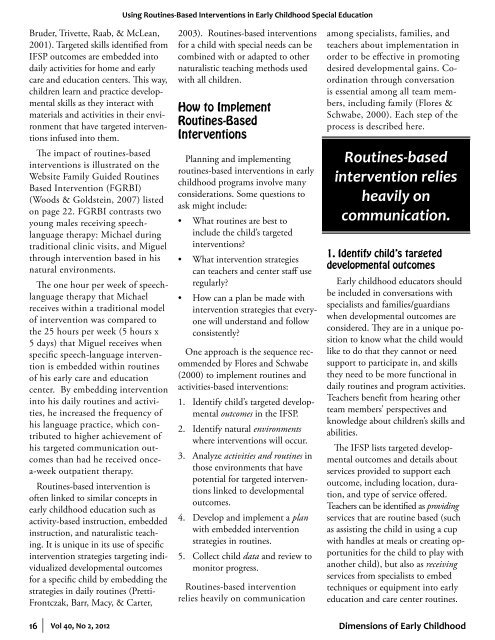Water Play - Southern Early Childhood Association
Water Play - Southern Early Childhood Association
Water Play - Southern Early Childhood Association
Create successful ePaper yourself
Turn your PDF publications into a flip-book with our unique Google optimized e-Paper software.
Using Routines-Based Interventions in <strong>Early</strong> <strong>Childhood</strong> Special Education<br />
Bruder, Trivette, Raab, & McLean,<br />
2001). Targeted skills identified from<br />
IFSP outcomes are embedded into<br />
daily activities for home and early<br />
care and education centers. This way,<br />
children learn and practice developmental<br />
skills as they interact with<br />
materials and activities in their environment<br />
that have targeted interventions<br />
infused into them.<br />
The impact of routines-based<br />
interventions is illustrated on the<br />
Website Family Guided Routines<br />
Based Intervention (FGRBI)<br />
(Woods & Goldstein, 2007) listed<br />
on page 22. FGRBI contrasts two<br />
young males receiving speechlanguage<br />
therapy: Michael during<br />
traditional clinic visits, and Miguel<br />
through intervention based in his<br />
natural environments.<br />
The one hour per week of speechlanguage<br />
therapy that Michael<br />
receives within a traditional model<br />
of intervention was compared to<br />
the 25 hours per week (5 hours x<br />
5 days) that Miguel receives when<br />
specific speech-language intervention<br />
is embedded within routines<br />
of his early care and education<br />
center. By embedding intervention<br />
into his daily routines and activities,<br />
he increased the frequency of<br />
his language practice, which contributed<br />
to higher achievement of<br />
his targeted communication outcomes<br />
than had he received oncea-week<br />
outpatient therapy.<br />
Routines-based intervention is<br />
often linked to similar concepts in<br />
early childhood education such as<br />
activity-based instruction, embedded<br />
instruction, and naturalistic teaching.<br />
It is unique in its use of specific<br />
intervention strategies targeting individualized<br />
developmental outcomes<br />
for a specific child by embedding the<br />
strategies in daily routines (Pretti-<br />
Frontczak, Barr, Macy, & Carter,<br />
16 Vol 40, No 2, 2012<br />
2003). Routines-based interventions<br />
for a child with special needs can be<br />
combined with or adapted to other<br />
naturalistic teaching methods used<br />
with all children.<br />
How to Implement<br />
Routines-Based<br />
Interventions<br />
Planning and implementing<br />
routines-based interventions in early<br />
childhood programs involve many<br />
considerations. Some questions to<br />
ask might include:<br />
• What routines are best to<br />
include the child’s targeted<br />
interventions?<br />
• What intervention strategies<br />
can teachers and center staff use<br />
regularly?<br />
• How can a plan be made with<br />
intervention strategies that everyone<br />
will understand and follow<br />
consistently?<br />
One approach is the sequence recommended<br />
by Flores and Schwabe<br />
(2000) to implement routines and<br />
activities-based interventions:<br />
1. Identify child’s targeted developmental<br />
outcomes in the IFSP.<br />
2. Identify natural environments<br />
where interventions will occur.<br />
3. Analyze activities and routines in<br />
those environments that have<br />
potential for targeted interventions<br />
linked to developmental<br />
outcomes.<br />
4. Develop and implement a plan<br />
with embedded intervention<br />
strategies in routines.<br />
5. Collect child data and review to<br />
monitor progress.<br />
Routines-based intervention<br />
relies heavily on communication<br />
among specialists, families, and<br />
teachers about implementation in<br />
order to be effective in promoting<br />
desired developmental gains. Coordination<br />
through conversation<br />
is essential among all team members,<br />
including family (Flores &<br />
Schwabe, 2000). Each step of the<br />
process is described here.<br />
Routines-based<br />
intervention relies<br />
heavily on<br />
communication.<br />
1. Identify child’s targeted<br />
developmental outcomes<br />
<strong>Early</strong> childhood educators should<br />
be included in conversations with<br />
specialists and families/guardians<br />
when developmental outcomes are<br />
considered. They are in a unique position<br />
to know what the child would<br />
like to do that they cannot or need<br />
support to participate in, and skills<br />
they need to be more functional in<br />
daily routines and program activities.<br />
Teachers benefit from hearing other<br />
team members’ perspectives and<br />
knowledge about children’s skills and<br />
abilities.<br />
The IFSP lists targeted developmental<br />
outcomes and details about<br />
services provided to support each<br />
outcome, including location, duration,<br />
and type of service offered.<br />
Teachers can be identified as providing<br />
services that are routine based (such<br />
as assisting the child in using a cup<br />
with handles at meals or creating opportunities<br />
for the child to play with<br />
another child), but also as receiving<br />
services from specialists to embed<br />
techniques or equipment into early<br />
education and care center routines.<br />
Dimensions of <strong>Early</strong> <strong>Childhood</strong>
















